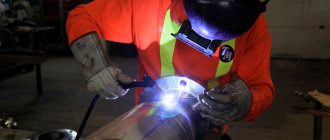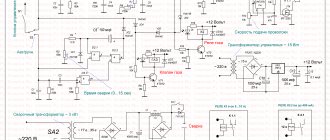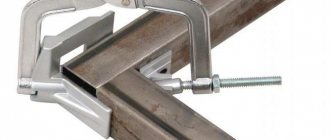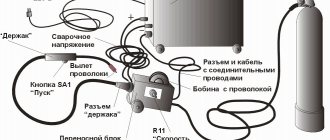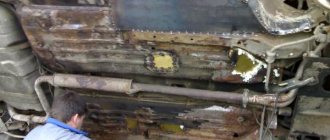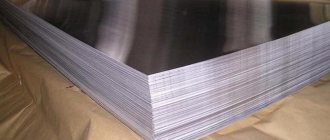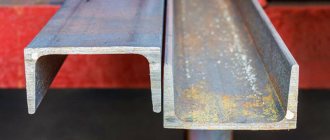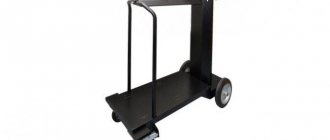What the article is about:
How to semi-automatically weld thick metal: gas consumption and wire thickness
Since the advent of semi-automatic welding machines, it has become a custom that they are used to weld thin body metal, where a conventional electrode cannot be handled. Indeed, semi-automatic welding copes well with workpieces of small thickness, leaving a very beautiful connection.
But what to do if you need to semi-automatically weld thick metal? Is it really that a semi-automatic machine and wire are not capable of welding metal 5 or more millimeters thick? How to semi-automatically weld thick metal, read in this article.
Semi-automatic welding machine: design and technology
- Power supply.
- A control system connected by an electrical circuit to a power source.
- Mechanism for feeding filler wire. It includes a gearbox, an electric motor and feed rollers, and can deliver wire by pulling, pushing or a combined method.
- A holder equipped with a channel for moving wire.
- Gas cylinder. It is not necessary if welding is performed using flux-cored wire: the shielding gas is formed by the combustion of the flux that fills its outer shell.
- Hoses, cables with holder and clamp.
semi-automatic welding device
Welding technology includes the use of shielding gases. Acetylene, hydrogen, pyrolysis, coke, and natural gases displace those environmental components that can significantly deteriorate the quality of the connection.
Before starting work, the current strength is set, which depends on the thickness of the surfaces being welded, as well as the electrode supply speed and shielding gas consumption. The amount of gas in the cylinder is checked, the metals to be joined are cleaned of dirt, varnish, paint, etc. Then, by unscrewing the gas supply valve, you can ignite the arc and begin welding. For the wire to enter the welding zone, just press the “start” button. During the process, the consumable must be positioned perpendicular to the part.
Semi-automatic welding of stainless metal parts
Semi-automatic welding of stainless metals is characterized by high productivity. In addition, it can be carried out in almost any conditions. To weld stainless steel structures, you need a welding machine that operates in an argon environment. The shielding gas helps prevent nitriding and oxidation of the created joint, which without the argon protection of the weld would begin to come into contact with the outside atmosphere and become weak. Argon is also suitable because even at particularly high temperatures it does not enter into any chemical reactions - it is much heavier than air, which helps to easily displace it in the welding area.
Welding of stainless metal with argon is carried out using electrodes made of non-consumable materials. During operation, they must be positioned strictly perpendicular to the surface being welded. If this condition is met, the weld will be of high quality.
Finally, it should be noted that at the moment semi-automatic metal welding has become particularly widespread in several areas of production closely related to metal processing. Semi-automatic welding is most in demand in the automotive industry. It is there that there is always a need for processing thin metals, for which semi-automatic welding is suitable. Often in the automotive industry, semi-automatic welding of metals with a thickness of 10 mm or less is used. Also, semi-automatic welding is often used in construction work, which often requires welding rigid metal structures of large thickness.
What and by what methods can be welded semi-automatically
Most often, semi-automatic welding is used for welding sheet metal - stainless steel, aluminum, non-ferrous metals. Products made of cast iron can also be welded. Knowing how to properly weld ferrous metals, you can begin welding non-ferrous ones.
Without the use of a semi-automatic machine when joining thin metals, it is difficult to imagine service station services, assembly and repair of household appliances, installation of all kinds of fences, containers for collecting and heating water in the country, etc. In industrial conditions (for example, in the automotive industry), semi-automatic welding is used when it is necessary to obtain high quality welds.
You can semi-automatically weld a car or replace sections of damaged parts using the butt welding method, but it requires some welding experience. The connection along the prepared holes should be made where the pre-cut patch is installed. Overlap welding, which involves point-to-point joining of surfaces, is accessible even to beginners.
Semi-automatic welding of non-ferrous metals
The process of semi-automatic welding of non-ferrous metals begins with checking the condition of the equipment. During its inspection, it is necessary to adjust the operating mode of the welding device, select the current strength, voltage level and wire speed. If the thickness of the metal being processed is less than three millimeters, then the suitable current strength is in the range of 120-145 amperes. In this case, the speed of movement of the wire should be 900 meters per hour.
After the equipment has been checked, the wire feed switch is turned to the operating position. Then the electric arc is ignited. If there is a melting wire, you just need to touch the metal surface. After igniting the electric arc, you can test the selected operating mode on test material. If the machine is functioning normally, you can proceed directly to welding.
When semi-automatic welding of non-ferrous metals, the torch must be moved in only one direction. It is best to weld parts at high speed and through one seam. If the non-ferrous metal is very thick, then it must be heated to 150-300°C.
Pros and cons of semi-automatic metal welding
Semi-automatic welding has a number of advantages:
- Suitable for beginner welders.
- There is no need to constantly remove slag from the weld area.
- There is no need to constantly change electrodes.
- Metal does not splash during operation.
The disadvantages include:
- It is impossible to use the device in windy conditions: protective gases will blow out from under the burner.
- The gas cylinder makes the design of the device somewhat cumbersome.
Preparing the device for welding
Before starting work, the machine is charged with a spool of welding wire. Using the broaching mechanism, its tension is adjusted. If the bobbin diameter does not match, use an adapter. After removing the nozzle and tip, remove the wire from the mechanism by about 15 cm, then, having installed the parts in place, cut off the excess length.
Install and secure the shielding gas cylinder. Make sure that the network is equipped with fuses, the welding mode is selected correctly, the type of gas matches the type of metal, and there are contact tips and wire feed rollers in stock. The mechanism is ready for operation.
You can find out how to set up a semi-automatic welding machine yourself here.
Security measures
The requirements for personal protective equipment for a welder do not differ from other welding technologies: the organs of vision and breathing must be reliably protected, and outer clothing must be made of materials that protect the worker from splashes of molten metal.
It is prohibited to use cylinders with an expired verification period. Mechanical or electromagnetic type safety valves must be in good working order.
Regardless of where the work is performed, we do not recommend using devices assembled with your own hands from inverters - this can lead to injury . We recommend that you familiarize yourself with the rating of manufacturers of semi-automatic welding machines. Russian-made devices enjoy a good reputation due to their reasonable cost and reliable performance. Numerous reviews confirm this.
How to weld thin metal using semi-automatic welding
Knowing how to properly weld thin metals, you can use welding with a semi-automatic inverter when repairing cars, making small-diameter pipes, water tanks, etc. The thickness of the welded metal is in the range of 0.2-4 millimeters. First of all, you need to choose the correct thickness of the electrodes, since electrodes with a thickness of more than 4 mm will extinguish the welding arc. So that it burns continuously, metal up to 1 mm is welded with electrodes of 0.5 - 2 mm. With a part thickness of 1.5 - 2 mm, the electrode will have a diameter of 2 - 2.5 mm. Professionals recommend semi-automatic cooking with 2-3 mm electrodes.
welding seam obtained using a semi-automatic machine
Welding metal 1 mm thick and thinner is a rather difficult task, since there is a high probability of burning through the seam. To avoid defects, you need to join the metal by electric welding using tacks. The distance between them should be 1.5 - 2 cm. Then short seams are made. After each of them, you need to take a short pause so that the metal has time to cool. A long weld joint can be obtained by welding metal surfaces alternately. In addition, to cool the parts, a copper or brass sheet located directly behind them is used, as well as ordinary moistened textiles, which are used to wipe the surface between the seams.
How to weld metal correctly if you are new to welding? The semi-automatic machine greatly simplifies the work, but some nuances should still be taken into account:
- it is necessary to select the correct welding mode.
- The connection of surfaces occurs at low currents (10-75 A).
- The wire feed speed is much lower than when welding thick metals.
- The movements of the torch must be uniform, otherwise the welding bead will overflow or the part will burn through.
- When spot welding, connections begin from the center of the workpiece, located below. This avoids metal filling the hole.
- By cleaning the surfaces from rust, dirt, traces of paint and degreasing them, you will not only get a more durable seam, but also avoid toxic fumes. When cleaning, do not remove a large layer of metal.
- The angle between the torch and the welding area should be 45 degrees.
- To obtain complete penetration, it is recommended to weld with a gap.
- The filler wire must have a long melting period.
- Be sure to wear protective clothing.
- First read the recommendations of experienced welders on how to weld thin metal.
You can read about labor protection during welding here.
Thin metal can be welded semi-automatically in horizontal, vertical, ceiling, and lower positions. The latter method is very popular. Many novice welders wonder how to weld thin metal in a vertical position? To obtain a vertical seam, take into account the thickness of the metal being welded:
- Up to 3 mm. Semi-automatic cooking is done from top to bottom.
- More than 3 mm. Welding is carried out in the direction from bottom to top.
Electroslag
In electroslag welding, slag is heated by electric current, which melts nearby metal and protects the weld from oxidation and saturation with hydrogen. The technology allows making only vertical seams from bottom to top. Deviation from the vertical is allowed within 30 degrees.
Copper slide plates are installed on both sides of the thick metal sheets being welded, which are cooled with water. A gap is left between the sheets being welded. No joint processing is required.
The joints and sliders form a weld pool. When an electrode is introduced into it, the slag heats up, the metal begins to melt, and welding occurs without creating an arc.
As the seam is formed, the sliders move upward. Everything happens in one pass. You can weld thick metal up to 60 cm. The seam must be formed in one pass, otherwise irreparable defects will occur. The technology allows the use of electrodes of various shapes.
How to weld thick metal using a semi-automatic machine
Having previously found out how thick the metal is to be welded, you can prepare it for this process according to all the rules. To weld thick metal - parts with a wall thickness of more than 4 mm - you need to chamfer the intended joints. Please note that this can be done using gas cutting, but hand and pneumatic chisels are also used. Metal sheets with a thickness of 5 - 15 mm are equipped with V-shaped bevels; for parts with a thickness of more than 15 mm, an X-shaped bevel is assumed.
semi-automatically welded thick metal
The seam when connecting thick surfaces, especially with T-joints, must be strengthened with the help of two more, located on its upper and lower edges. The arc must not be drawn along a straight line, but must be made in zigzag or reciprocating movements. The weld metal should extend onto the surface of the product to a width equal to the thickness of this part. To obtain a reliable connection, cascade or slide welding is most often used.
When welding thick metal, there is a high probability that the anti-corrosion coating of the part will be damaged. Therefore, after welding, the part must be treated with special compounds. If it is made of low-alloy steel, then preheating will not hurt. Heat treatment will soften the product, preparing it for further work.
How to weld thick metal while maintaining the original qualities of the part? To reduce deformation or completely prevent it, thick metal products are securely fixed using clamps before welding. This can be done on a workbench, assembly table or steel plate.
The connection of massive parts using semi-automatic welding is carried out in accordance with GOST 14771-76. To ensure the strength of the joints, it is necessary to follow the general rules: correctly prepare the edges of the parts, set the welding current in certain ranges, and ensure the supply of the required amount of carbon dioxide to the welding zone.
Types of sutures and methods of applying them
According to the position and type of connection, seams are divided into several types, which determine the welding settings.
According to their position in space they are divided into:
They can be overlapped, end-to-end, and there are also T-joints and corner joints. There are several methods for placing seams when welding thick metal.
Overlay methods
The method of welding thick metal in a cascade is as follows: the entire section is divided into 20 cm sections. First, the lowest section, called the root section, is welded.
Its length is approximately 20 cm. A new layer is made over the root overlap, without interrupting the arc. Its total length will be 20 +20 = 40 cm. The welding method is best understood in the diagram. It is applied to thick metals when the sheet thickness is more than 20mm. With this welding method, layers are applied to uncooled metal, which reduces deformations and internal stresses.
Welding thick metal with a slide is similar to a cascade, only two welders work from the middle to the edges of the seam.
They cascade along the length and width. The goal is to ensure that the contact area is hot when applying the next layer.
Length
Seams are divided into short ones up to 25 cm long, medium ones up to 1 m, and long ones over 1 m. Short ones are laid in one pass.
When welding thick metal, it is necessary to make several layers - one for each pass, since each subsequent layer becomes wider, the welder makes zigzag or spiral movements across the seam. Thus, the edges of the welded parts are melted.
This technology is usually used for butt joints of thick metal. Medium and long sutures are applied using the cascade and slide methods.
When welding corner and T-joints, a multi-layer, multi-pass double-sided weld is used. First, the root seam is formed. Then a second layer is laid on top of it with an offset to one of the joints, then a third with an offset to the second joint with its melting.
The fourth goes on top of the second layer, melting the edge of the part. The fifth passes next to the fourth, and the sixth layer on top of the third, melting the edge of the second part. The seventh layer is applied on top of the fourth, fifth and sixth layers.
On the back side of the seam, the eighth finishing layer is applied to the first layer and the edges of the product.
Welding machine parameters
Reducing the welding current reduces the depth of the weld pool and vice versa.
Its width practically does not change. The required current depends on the thickness of the metal and the diameter of the welding electrode. An increase in voltage leads to an increase in the width of the seam, while the penetration depth decreases. The penetration depth depends on the speed of movement of the electrode, all other things being equal. It increases at speeds up to 40 m/hour, and then decreases. The seam width decreases continuously with increasing speed.
Working with thick metal requires more training for the welder. The seam always turns out to be multi-layered. Before taking on such welding, it is necessary to master the basic technological techniques.
Technological features of semi-automatic welding of thick metal
In order for welded metal structures to withstand loads, it is necessary to create reliable connections:
- seams must firmly connect all elements of the product;
- it is necessary to relieve the stresses that arise after welding inside the alloys . You can use preheating for this. After welding, it is recommended to ensure slow cooling;
- It is important to obtain a weld leg determined by technology ; this also strengthens the metal structure.
It should be taken into account that when working at high currents there is a risk of deformation, this means that the control dimensions of the part will change, and the shape of the structure will differ from that which was planned.
Necessary equipment and materials
To work you will need:
- Powerful welding machine . The maximum value of welding current is not less than 250 A.
- Cylinder for storing and transporting carbon dioxide . There are containers with a volume of 5, 10 and 40 liters. The cylinders are painted black.
- Reducer for reducing gas pressure . A special CO2 device is required. It is desirable to have a heating element.
- Hose and clamps - for connecting the cylinder.
For semi-automatic welding of steels, use wire type Sv-08G2s or similar for welding carbon steels 08x18n9t, as well as an equivalent for welding corrosion-resistant steels. Diameter – 1 to 1.6 mm. Common reels weigh 5, 15 and 18 kg.
Approximate cost of wire for welding carbon steels on Yandex.market
Some devices operating on a 220-volt network can only accommodate small coils of wire.
Setting up the device and gas equipment
Semi-automatic welding machines from different manufacturers are designed differently. There are at least two or three regulators on the front panel:
- setting the wire feed speed – the rotation speed of the electric motor that moves the wire is adjusted;
- change in current strength - the parameter affects the melting rate of the additive in the weld pool;
- inductance adjustment - the change concerns the current characteristics. At minimum values, the depth of metal penetration is less and the seam is more convex. For welding thick workpieces, it is recommended to increase it to medium or even higher.
Tip: you can set up the device by ear. During welding, the melting of the wire occurs very smoothly, the semi-automatic machine produces an even rustling sound.
After connecting the reducer to a carbon dioxide cylinder, you need to set the outlet pressure. For indoor work, 1-1.5 kg/sq.m. is sufficient. cm. If a flow meter is installed on the gearbox, then it should be set to 10-12 liters per minute.
How to weld thin metal 1 mm to thick metal 15 mm with an electrode
Friends, I welcome everyone to our channel. Those who are visiting us for the first time should know that this channel is for self-taught beginners in manual arc welding. Here we give only proven advice based on many years of welding practice. You won't find such recommendations in books.
Today I will tell you important information on how a self-taught beginner can weld metals of different thicknesses together. For example, two plates with a thickness of 1 mm and 15 mm will be welded. Surprised? No, this is quite possible if you know the three basic rules of such welding.
Preparation for work. Edge processing
Welding work using a semi-automatic machine should be carried out only with clean workpieces. The surface should be free of rust, oil and dirt. Otherwise, pores will appear.
Proper cutting of edges is an important stage in preparing parts for welding. To ensure the formation of high-quality seams, chamfers should be removed in accordance with GOST 14771-76 - depending on the type of connection. If everything is done correctly, the connection will be strong. It is important to ensure that the metal is fused throughout its entire thickness.
Edge preparation
The term “thick-walled workpiece” or “thick-sheet workpiece” in welding refers to products with a joining edge thickness of 20 millimeters or more.
Of course, before welding the workpieces, such edges are prepared in a special way, namely:
- First, grind the first edge under the U-shaped profile.
- Secondly, grind the second edge under the stepped profile.
Without such preliminary preparation, welding thick sheet metal with an electrode of any thickness is practically impossible. Moreover, on the outer plane (in the upper part, from the side of the electrode insertion) of the joined parts, a gap of 10-15 millimeters or more should form between the edges, and on the inner plane (in the lower part) the gap should be practically zero.
If you do not make a mistake with the dimensions of the edges, then you can count on a double increase in the welder’s labor productivity (the speed of welding will increase) and a 25 percent saving in filler material (electrodes or wire).
Welding of thick-walled pipes and thick-sheet blanks
When joining thick-walled workpieces, the following technologies for welding the gap between parts are used:
- Technique for sequential suturing
- Technique of sequential cascade sutures.
- Technique of sequential or parallel block sutures.
And further in the text we will consider all three processes.
Welding "slide"
The first technology – forming a seam “slide” – is based on the following welding scheme:
- The first seam is placed at the bottom of the gap between the parts, using a 5 mm electrode for this purpose. The thickness of the seam in this case should be equal to one third of the thickness of the metal being welded.
- After the scale has broken down and the spatter has been removed, a second one is applied from one wall of the gap to the other, on top of the first seam. The total height of the joining seam (first and second) in this case is equal to two-thirds of the metal thickness.
- Guided by a similar principle, the welder applies a third layer of molten metal to the “hill” of the second seam, cleared of scale and splashes. The thickness of the seam in this case is equal to the thickness of the metal.
- The last, fourth seam is used to weld the space between the mound and the edges of the ends of the workpieces.
Welding process
Thick pieces should not be cooked in one pass. Sequence of actions after preparatory work:
- Assembling elements on tacks.
- Checking the dimensions of the future part.
- Boiling the root of the seam.
- Filling the groove between the edges in several passes.
- Creating a facing seam.
- Processing joints using a grinder with a grinding wheel.
The tack is a full-fledged short seam about 15-25 mm long with a pitch of 45-50 cm. It is welded at the same current as the entire product. The tacks should be positioned so that the future product becomes rigid and does not “lead” during welding.
If you want to eliminate (or minimize) deformation from heating, it is recommended to fix the part on the assembly table using clamps or clamps. You can temporarily grab it to a workbench or steel plate.
First pass. Root of seam
The root seam is the first and most important welded connection between the edges, which is as far as possible from the front part of the parts. It is important to ensure that a roller is formed on the reverse side, smoothly connecting both elements.
If the root weld is welded with defects, cracks may appear during operation of the part, which can lead to destruction of the entire structure.
During operation, you must ensure that the part does not heat up too much. If the cascade welding method is used, a root weld is not required.
Filling the space between welded edges
Thick metal must be welded in several passes, filling the space between the edges. The cascade welding method or the “slide” method is often used:
- “cascade” - this option involves the simultaneous formation of the root of the seam and filling the space between the edges. First, a section of the root connection about 20-25 cm long is welded. Next, a second seam 40-50 cm long is applied, half of which lies on the root. The third - 60-65 cm long - partially (by two thirds) overlaps the previous ones, and ⅓ will become root. The fourth seam (also about 60-65 cm) should overlap the third and reach the thickness of the metal above the root part of the second. This method is similar to step welding;
- “slide” - after welding the root, a second seam is welded, connecting the edges and overlapping the first. After it, the third and fourth (facing) are applied.
Due to the fact that the semi-automatic machine allows you to continuously feed wire into the weld pool, you can form long seams at high speed.
Welding in vertical and overhead positions
The peculiarities of working in positions other than horizontal are that the metal is difficult to hold; under the influence of gravity, it tends to flow out of the weld pool. To avoid this, two methods are used.
- Reducing the welding current by 15-20% . The metal heats up less intensely and crystallizes faster.
- Welding with separation . Short sutures are applied one after another. In a vertical position, you should go from bottom to top. Welding from top to bottom is not allowed due to possible lack of penetration.
Whenever possible, avoid working in positions other than horizontal. Welding vertical and ceiling seams requires more careful preparation of the edges and is considered less productive and more labor-intensive.
Electric arc
Welding metal of large thickness (20 mm or more), due to the impossibility of welding the entire thickness of the product in one pass, has its own specifics. The edges of the surfaces to be welded must be prepared.
To do this, the edges are ground at an angle. When connecting the parts, the cross-section should form the letter V. Sometimes, one edge is ground at an angle, and the other in steps. A gap is left between the parts to be welded; in the upper part there should be a groove 10-15 mm wide or more.
The width of the groove depends on the thickness of the metal. When welding metal of different thicknesses, the edge of the thicker one is ground down to the thinner section.
When butt welding and the presence of intersecting seams, stresses arise, leading to deformation and even destruction of the product. This is especially pronounced at low temperatures, when the metal loses its plastic properties.
Rigid fastening of parts in the tooling also causes excessive stress. Long seams with a large cross-section also lead to this.
It is necessary to weld a thick metal sheet so that the time between applying subsequent layers is minimal . To avoid stress, it is necessary to lay the next seam on a hot layer. The thickness of the layers should be within 4-5 mm, this will ensure sufficient heating.
When welding thick metal, due to the large depth of the weld pool, the likelihood of pore formation increases. To prevent this from happening, a cascade welding method or the “slide” method is used.
During welding, transverse shrinkage occurs, which can reach 4 mm with a metal thickness of 40-50 mm. When welding thick sheets, it is necessary to make tacks 2-3 cm long every 30-50 cm.
Features of flux-cored wire welding
If shielding gas is required when working with copper-plated wire, then the use of powdered wire does not require it. The process is reminiscent of electrode welding - with the formation of a slag crust that must be removed. The wire coating contains elements (flux) that, when heated, protect the weld pool from exposure to air. Distinctive features:
- high mobility - no need to move cylinders around the work site;
- Many varieties of wire grades allow you to choose the one that is needed in specific conditions;
- flux-cored wire is often used during outdoor work ; in this case, gusts of wind do not interfere with the process, unlike welding with gas.
The main disadvantage is the high cost. On average, flux-cored wire is 50% more expensive than regular copper-plated wire.
Defects that occur when welding massive parts. How to avoid problems
During work, problems may arise that affect the quality of connections.
| Description of the defect | Causes and remedies |
| Pores appear during welding |
|
| The seam is too convex | It is necessary to configure the semi-automatic machine correctly. Adjust wire feed speed and current value. Test on unnecessary scraps of metal. The wire should flow smoothly into the welding zone and melt in a timely manner without cracking or clicking. |
| Spattering of metal during welding |
|
If a metal structure has a complex shape and there is concern that it will deform during welding, assemblers often grab additional temporary reinforcements from corners, channels or reinforcement in critical places. They allow you to keep the dimensions of the product within specified limits. When the part has cooled, they can be cut off.
Welding massive parts with a semi-automatic machine is considered the most productive method. With a minimum of effort you can get beautiful and reliable connections.
Features of welding thin metal, and how to weld a burn
